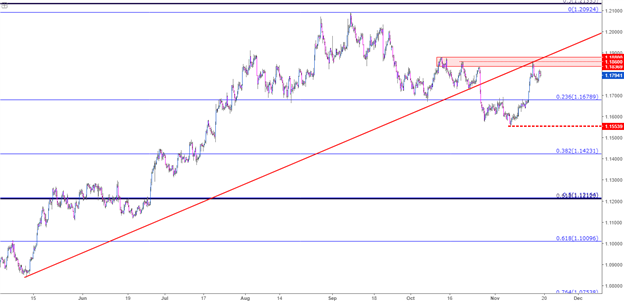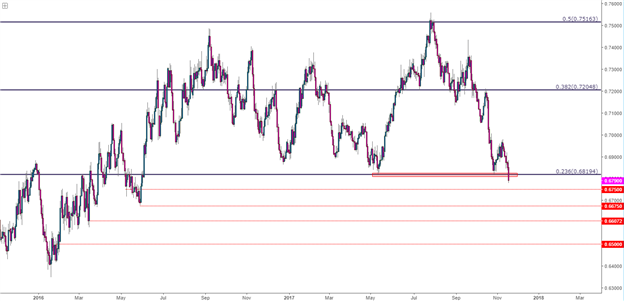Talking Points:
- The U.S. Dollar remains in a precarious position as we near a holiday-shortened week, with Thanksgiving in the United States on Thursday.
- EUR/USD positioning remains stretched at -2.24, and this could be pointing to additional topside in the pair/USD weakness. Click here to access IG Client Sentiment.
- Looking for trade ideas? Check out our trading guides. And if you’re looking for something more interactive in nature, check out our DailyFX Webinars.
To receive James Stanley’s Analysis directly via email, please sign up here
The U.S. Dollar remains in limbo, at least in the near-term, after the strength seen over the previous few weeks pulled back to a key level of support on Tuesday. Follow-thru price action on Wednesday and Thursday was unable to get back into that bullish trend, with sellers continuing to offer resistance below prior areas of support. This puts the U.S. Dollar in a precarious position as we near a holiday-shortened week in the United States with Thanksgiving next Thursday.
U.S. Dollar via ‘DXY’ Four-Hour: Bullish Theme on the Ropes, Prior Swing Support Holds

Chart prepared by James Stanley
Next week’s calendar is largely front-loaded, and relatively quiet. The theme du jour is Central Bank speak, and for American traders, Thanksgiving morning offers a couple of drivers of relevance with the release of meeting minutes from the October ECB rate decision along with a speech from SNB President, Thomas Jordan. The week starts off with a speech from RBA Governor, Dr. Phillip Lowe, and on Tuesday evening we hear from Fed Chair Janet Yellen speaking at Stern Business School at NYU. The following morning brings the release of U.S. Durable Goods, and at 2:00 PM ET we get the meeting minutes from the Fed’s rate decision earlier in the month.
So, despite the holiday-shortened week, the recipe remains for a continuation of volatility. Below, we look into major FX markets of relevance as we approach next week.
EUR/USD
This is probably the most pensive scenario around the U.S. Dollar at the moment. DXY carries a roughly 57.6% allocation of the Euro, so the argument can be made that DXY is very ‘Euro-heavy’. This also means that when the Euro is pricing in specific drivers, such as ECB stimulus or the potential for an ECB stimulus exit; DXY can get contorted by the move in the Euro. Present tense is a great example: If we look at DXY, we’ll see relative weakness; and that shows through very well in the recent strength of EUR/USD. But – at the same time, we’re seeing considerable USD strength against Aussie and New Zealand Dollars.
Yesterday we discussed the likely reason as to why so much strength has shown-up in the Euro so quickly after the rate decision that saw the ECB extend QE into 2019. German GDP numbers released on Tuesday came-in red-hot, and this drove Euro-Zone GDP growth to .6% for last quarter. This puts Europe on pace to outgrow the United States this year, and the representative Central Banks have been on considerably divergent paths. While the Fed has hiked rates four times in the past two years, with a fifth apparently on the way in December, the ECB is nowhere near tighter policy after having just extended QE for another nine months.
If this growth story is to continue, it appears as though the ECB will have some catching up to do while the Federal Reserve can take a more gradual approach to future rate hikes. The return of the bullish theme is not yet completely confirmed: As we discussed yesterday, there are setups on both sides of EUR/USD and that fact remains as we head towards the weekend.
There is a valid case for bearish continuation, as price action is finding resistance on the under-side of a prior trend-line along with a batch of resistance that had held the October highs in the pair. If we do take out that group of prior swing highs that runs up to 1.1880, the prospect of bullish continuation will look considerably more attractive.
EUR/USD Daily: Resistance at Under-Side of Trend-Line, October Swing Highs

Chart prepared by James Stanley
While the U.S. Dollar has been relatively weak against the Euro, we’ve seen a far different story against the Australian Dollar. The Aussie is in the process of hurdling down to fresh five month lows, fast approaching the vaulted psychological level of .7500 in the pair.
As we’ve been following, the short-side of AUD/USD has been considerably more attractive for USD-strength plays than EUR/USD or GBP/USD. We added to the position last week via an Analyst Pick, and this morning’s drop hit the first target of the most recent addition to the position along with a break-even stop. For next week – traders will want to be cautious of triggering fresh shorts so near that key psychological level of .7500. For short-side re-entry, there are a couple of mechanisms that can help.
The first way of approaching is to let prices pull back to some form of resistance so that the initial risk on the entry can be controlled. We look at a few of these potential pullback levels below, demarcated in red. The second method of approach is to let the breakout below .7500 take place to allow the market to ‘show its hand,’ or, said otherwise, to confirm that a break below .7500 will even be possible with our current context. At that point, traders can then look for prices to pull back to that key level in the effort of using that prior support as fresh resistance.
AUD/USD Four-Hour: Falling Towards .7500, Potential Resistance Levels Applied

Chart prepared by James Stanley
The pain in the New Zealand Dollar continues and this is another area in which we’ve seen rather profound USD-strength in the recent past. The selling in the Kiwi really began to heat up around the election of newly-installed PM Jacinda Ardern. Ms. Ardern has some unique ideas, and she’s already started the process of implementation. The very role of the RBNZ is in question, and the bank is currently led by interim Governor, Grant Spencer. For a more detailed explanation, we discussed the backdrop around this situation in our Kiwi-Dollar forecast two weeks ago entitled, The New Zealand Dollar and The Tides of Change Ahead of the RBNZ.
NZD/USD had produced a double-bottom formation when prices bounced off of the 2017 low in late-October, which was showing around .6818. Given the context of NZD/USD, we were looking at a double-bottom breakout should prices fall below this floor, leading to a fresh 2017 low. That break-down began last night, and prices are continuing to fall as we head towards weekend.
But, as we looked at in Aussie earlier, chasing a fresh breakout on a Friday can be a challenging way of trying to trade momentum. Rather, traders can use the information given from the move – the ability of sellers to take over – into approaches for next week. On the chart below, we’ve added four subordinated support levels. Traders can now look for prices to move down to fresh support, at which point the prior level of support can become new resistance. Meaning – if we get a run to .6750, the prior support level of .6818 can be utilized for resistance on down-side continuation approaches.
NZD/USD Daily: Double-Bottom Breakout Down to Fresh 2017 Lows

Chart prepared by James Stanley
--- Written by James Stanley, Strategist for DailyFX.com
To receive James Stanley’s analysis directly via email, please SIGN UP HERE
Contact and follow James on Twitter: @JStanleyFX






